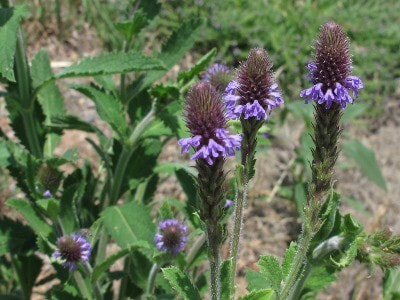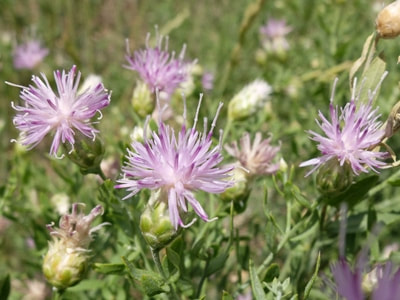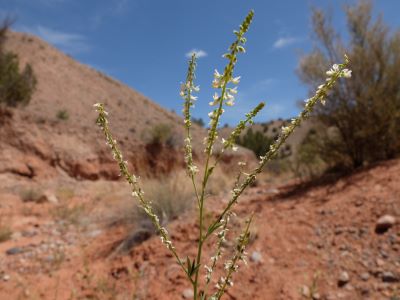|
The Bloom Blog Blooming this week in the environs of Abiquiú By Wildflowers of the Southern Rocky Mountains Found in pine forests, roadsides
Seen blooming in July by SR285, south of Tres Piedras MacDougall’s Verbena grows over three feet tall with stiff, branched stems. Leaves are long and toothed. The whole plant is hairy and resembles some members of the mint family, but it does not have the aroma. The long, thick, dense flower spikes have a ring of small flowers at one level which moves up the spike as the flower matures. Traditionally the Navajo used MacDougall’s Verbena in various ceremonial ways as a lotion and fumigant and a cold infusion was taken and used as lotion for fever. Source. If you are trying to identify a different flower then you can check what other flowers bloom this month. If you cannot identify a flower from the website, send a photo and where you took it to [email protected]. Read online for tips.
0 Comments
The Bloom Blog Blooming this week in the environs of Abiquiú By Wildflowers of the Southern Rocky Mountains Found in ditches, roadsides, pastures
Seen blooming in late June by SR 554 south of El Rito Russian Knapweed grows in a bush one to three feet high with stiff branches and forms dense colonies with creeping roots. Flowers are ½ to ¾ inch across and thistle-like, ranging from white to pink to lavender in color. Bracts are smooth with rounded tips, green and cobwebby. It is toxic to horses and considered a highly invasive, noxious weed by the State of New Mexico and many other states. A single Russian knapweed plant can produce about 1,200 seeds per year. The findings of a recent study suggest it is a promising source of natural antioxidant, antimicrobial, anti-cholinesterase and anti-amylase agents for the management of oxidative damage, and pharmaceutical, food, and cosmeceutical purposes. In folk medicine, the plant has been used for many years as an emetic, anti-epileptic and anti-malaria remedy. Source. If you are trying to identify a different flower then you can check what other flowers bloom this month. If you cannot identify a flower from the website, send a photo and where you took it to [email protected]. Read online for tips. White Sweet Clover, Honey Clover, Bee Clover, White Melilot,Melilotus albus,Pea Family (Fabaceae)6/28/2024 The Bloom Blog Blooming this week in the environs of Abiquiú By Wildflowers of the Southern Rocky Mountains Found in disturbed soil, roadsides, streambanks
Seen blooming in June in Red Wash Canyon White Sweet Clover grows with an airy, bushy habit to six feet tall with many branches and tiny, fragrant, white flowers growing in long clusters. Leaves are divided into three leaflets. It could be mistaken for alfalfa before it blooms. It is not native to North America and was introduced from Europe as a forage crop, and is now used to stabilize bare slopes, for soil-building, and is planted by beekeepers for the nectar of its flowers. It likes fire and can erupt in an explosion of growth following a burn. The young leaves can be eaten raw, preferably before the plant blossoms. They are bitter and aromatic, usually used as flavoring in salads. The whole plant thoroughly dried can be used to make a tea with a hint of vanilla. The seeds can be used as a spice. Fermented or moldy clover should never be used. Source. It has been considered a medicinal plant since ancient times; Hippocrates, the father of medicine, used Sweet Clover herb to treat skin ulcers. Sweet Clover produces a coumarin compound that can be converted to dicoumarin, which is used medicinally as a blood thinner and an anticoagulant in rat poisons. It has also been used medicinally to treat external and internal inflammation and stomach and intestinal ulcers. Sweet Clover inflorescences have been used in eye lotions. Source If you are trying to identify a different flower then you can check what other flowers bloom this month. If you cannot identify a flower from the website, send a photo and where you took it to [email protected]. Read online for tips. The Bloom Blog Blooming this week in the environs of Abiquiú By Wildflowers of the Southern Rocky Mountains Found in dry, sandy, open areas Seen blooming in June on the Espinosa Trail, Abiquiu Fineleaf Hymenopappus is easily overlooked because it has no petal-like ray flowers and small flower heads. It is usually a woolly/hairy plant with stems branching from a rosette or mound of basal leaves. Leaves are twice-divided into narrow or thread-like leaflets which are sometimes covered in woolly hairs, giving a grey appearance. Tubular disk flowers have five lobes and range in color from very yellow to almost white. Thirteen varieties have been identified. This variety, cinerus, grows to 2½ feet high covered in dense white hair in a more rounded bushy form. Basal and stem leaflets are very finely divided. Flowers are less than ½" across and yellow. Traditionally, a poultice of the root with lard was applied to ease swellings, and a decoction of the root was taken as an emetic. The root was also used as a chewing gum, and the leaves were boiled and baked into bread. Source. If you are trying to identify a different flower then you can check what other flowers bloom this month. If you cannot identify a flower from the website, send a photo and where you took it to [email protected]. Read online for tips. The Bloom Blog Blooming this week in the environs of Abiquiú By Wildflowers of the Southern Rocky Mountains Found in meadows, open conifer forests
Seen blooming in June by FS Road 137, Carson National Forest Larkspur grows to eighteen inches high with pale lavender to deep blue flowers, rarely white. The flowers have a long ‘spur’ to the rear of the flower which apparently resembles a Lark's foot structure giving it its common name. Leaves are deeply divided and found mostly on the lower part of the stem. All parts of the plant are toxic and poisonous to livestock, particularly when the plant is young. A blue dye can be made from the flowers, which has also been used as ink. Traditionally, native peoples have used the blue flowers for coloring arrows and other items, or for various ceremonies. Source. \ If you are trying to identify a different flower then you can check what other flowers bloom this month. If you cannot identify a flower from the website, send a photo and where you took it to [email protected]. Read online for tips. |
AuthorI am Marilyn Phillips, a native of England, whose love of nature and the outdoors from childhood brought me by a circuitous route to Crested Butte, Colorado in 1993 and 16 years later to northern New Mexico. My exploration of the many trails in these areas, my interest in wildflowers and photography, and career in computer system design came together in this creation. If you have any corrections, comments or questions, please contact me by email. Archives
July 2025
Categoriescopyright © 2020
|







 RSS Feed
RSS Feed